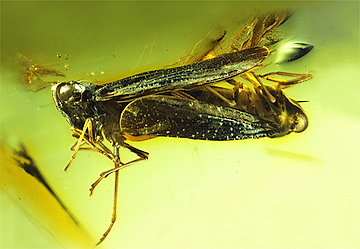Abstract
Libanoephemera inopinatabranchia gen. and sp. nov., an ephemeropteran nymph from the Lower Barremian dysodiles of Lebanon, is herein characterized, described, illustrated and assigned to an incertae sedis family. It differs from all known ephemeropteran nymphs and is characterized by hypognathous mouthparts, hind wing pads not covered by fore wing pads, legs with five-segmented tarsi and presence of five pairs of gills on abdominal segments; abdominal segments I and III–V with two-branched gills; segment VI bearing complex gills with six branches.
References
Béthoux, O. (2015) The Late Carboniferous Triplosoba pulchella is not a fly in the ointment but a stem-mayfly. Systematic Entomology, 40, 342–356.
https://doi.org/10.1111/syen.12103
Botta, P. (1831) Sur la structure géognostique du Liban et de l’Anti-Liban. Bulletin de la Société Géologique de France, 10, 234–239.
Carpenter, F.M. (1992) Treatise on invertebrate paleontology. Part R, Arthropoda 4: Superclass Hexapoda 3/4. Geological Society of America, New York, 655 pp.
Cordier, L. (1808) Sur le dysodile, nouvelle espèce minérale. Journal des Mines, 23, 271–274.
Demoulin, G. (1970) Remarques critiques sur des larves «éphéméromorphes» du Permien. Bulletin de l’Institut Royal des Sciences Naturelles de Belgique, 46, 1–10.
Edwards, W. (1929) Lower Cretaceous plants from Syria and Trans-Jordania. The Annals and Magazine of Natural History, Series 10, 4 , 394–405.
https://doi.org/10.1080/00222932908673072
El Hajj, L., Baudin, F., Littke, R., Nader, F.H., Gèze, R., Maksoud, S. & Azar, D. (2019) Geochemical and petrographic analyses of new petroleum source rocks from the onshore Upper Jurassic and Lower Cretaceous of Lebanon. International Journal of Coal Geology, 204, 70–84.
https://doi.org/10.1016/j.coal.2019.02.003
Fraas, O. (1878) Geologisches aus dem Libanon. Jahreshefte des Vereins für vaterländische Naturkunde in Württemberg, 34, 257–391.
Heckman, C.W. (2002) Encyclopedia of South American Aquatic Insects: Ephemeroptera. lllustrated Keys to Known Families, Genera, and Species in South America. Springer, Dordrecht, 419 pp.
https://doi.org/10.1007/978-94-010-0528-9
Huang, J.D., Sinitshenkova, N.D. & Ren, D. (2011) New Mayfly Nymphs (Insecta: Ephemeroptera) from Yixian Formation, China. Paleontological Journal, 45 (2), 167–173.
https://doi.org/10.1134/S0031030111020092
Hubbard, M.D. & Kukalová-Peck, J. (1980) Permian mayfly nymphs: new taxa and systematic characters. In: Flannagan, J.F. & Marschall, K.E. (Eds). Advances in Ephemeroptera biology. Proceedings of the 3rd International Conference on Ephemeroptera, Plenum, New York, London: 19–31.
https://doi.org/10.1007/978-1-4613-3066-0_2
Janensch, W. (1925) Fische aus dem Dysodil des Wealden vom Libanon. Zeitschrift der Deutschen geologischen gesellschaft (Abhandlungen und Monatsberichte), 53–59.
Kukalová, J. (1968) Permian mayfly nymphs. Psyche, 75, 311–327.
Lin, Q.B. & Huang, D.Y. (2001) Description of Caenoephemera shangyuanensis, gen. nov., sp. nov. (Ephemeroptera), from the Yixian Formation. The Canadian Entomologist, 133, 747–754.
https://doi.org/10.4039/Ent133747-6
Misof, B. Liu, S., Meusemann, K., Peters, R.S., Donath, A., Mayer,C., Frandsen, P.B., Ware, J., Flouri, T., Rolf G. Beutel, R.G., Niehuis, O., Petersen, M., Izquierdo-Carrasco, F., Wappler, T., Rust, J., Aberer, A.J., Aspöck, U., Aspöck, H., Bartel, D., Blanke, A., Berger, S., Böhm, A., Buckley, T.R., Calcott, B., Chen, J., Friedrich, F., Fukui, M., Fujita, M., Greve, C., Grobe, P., Gu, S., Huang, Y., Jermiin, L.S., Kawahara, A.Y., Krogmann, L., Kubiak, M., Lanfear, R., Letsch, H., Li, Y., Li, Z., Li, J., Lu, H., Machida, R., Mashimo, Y., Kapli, P., McKenna, D.D., Meng, G., Nakagaki, Y., Navarrete-Heredia, J.L., Ott, M., Ou, Y., Pass, G., Podsiadlowski, L., Pohl, H., von Reumont, B.M., Schütte, K., Sekiya, K., Shimizu, S., Slipinski, A., Stamatakis, A., Song, W., Su, X., Szucsich, N.U., Tan, M., Tan, X., Tang, M., Tang, J., Timelthaler, G., Tomizuka, S., Trautwein, M., Tong, X., Uchifune, T., Walzl, M.G. Wiegmann, B.M., Wilbrandt, J., Wipfler, B. Wong, T.K.F., Wu, Q., Wu, G., Xie, Y., Yang, S., Yang, Q., Yeates, D.K., Yoshizawa, K., Zhang, Q., Zhang, R., Zhang, W., Zhang, Y., Zhao, J., Zhou, C., Zhou, L., Ziesmann, T., Zou, S., Li, Y., Xu, X., Zhang, Y., Yang, H., Wang, J., Wang, J., Kjer, K.M. & Zhou, X. (2014) Phylogenomics resolves the timing and pattern of insect evolution. Science, 346 (6210), 763–767.
https://doi.org/10.1126/science.1257570
Prokop, J. & Nel, A. (2009) Systematic position of Triplosoba, hitherto the oldest mayfly from Upper Carboniferous of Commentry in Central France (Insecta: Palaeodictyopterida). Systematic Entomology, 34, 610–615.
https://doi.org/10.1111/j.1365-3113.2009.00495.x
Sinitshenkova, N.D. (1975) Mayfly larvae of the family Hexagenitidae (Insecta, Ephemeroptera). Paleontological Journal, 9 (1), 82–86.
Sinitshenkova, N.D. (2013) New mayflies (Insecta: Ephemerida = Ephemeroptera) from the intertrappean deposits of the Tunguska basin, Siberia. Paleontological Journal, 47, 84–88.
https://doi.org/10.1134/S0031030113010127
Tshernova, O.A. (1965) Some fossil mayflies (Ephemeroptera, Misthodontidae) from Permian beds of the Ural. Entomological Review, 44, 202–207.
Türkmen, C. & Kazanci, N. (2013) The key to the Ephemeroptera (Insecta) larvae in running waters of the Eastern Black Sea Basin (Turkey) with the new records. Review of Hydrobiology, 6 (1), 31–55.
Zhang, J.F. & Kluge, N.J. (2007) Jurassic larvae of mayflies (Ephemeroptera) from the Daohugou formation in Inner Mongolia, China. Oriental Insects, 41, 351–366.
https://doi.org/10.1080/00305316.2007.10417519
Zumoffen, G. (1926) Géologie du Liban. Barrière, Paris, 126 pp.

